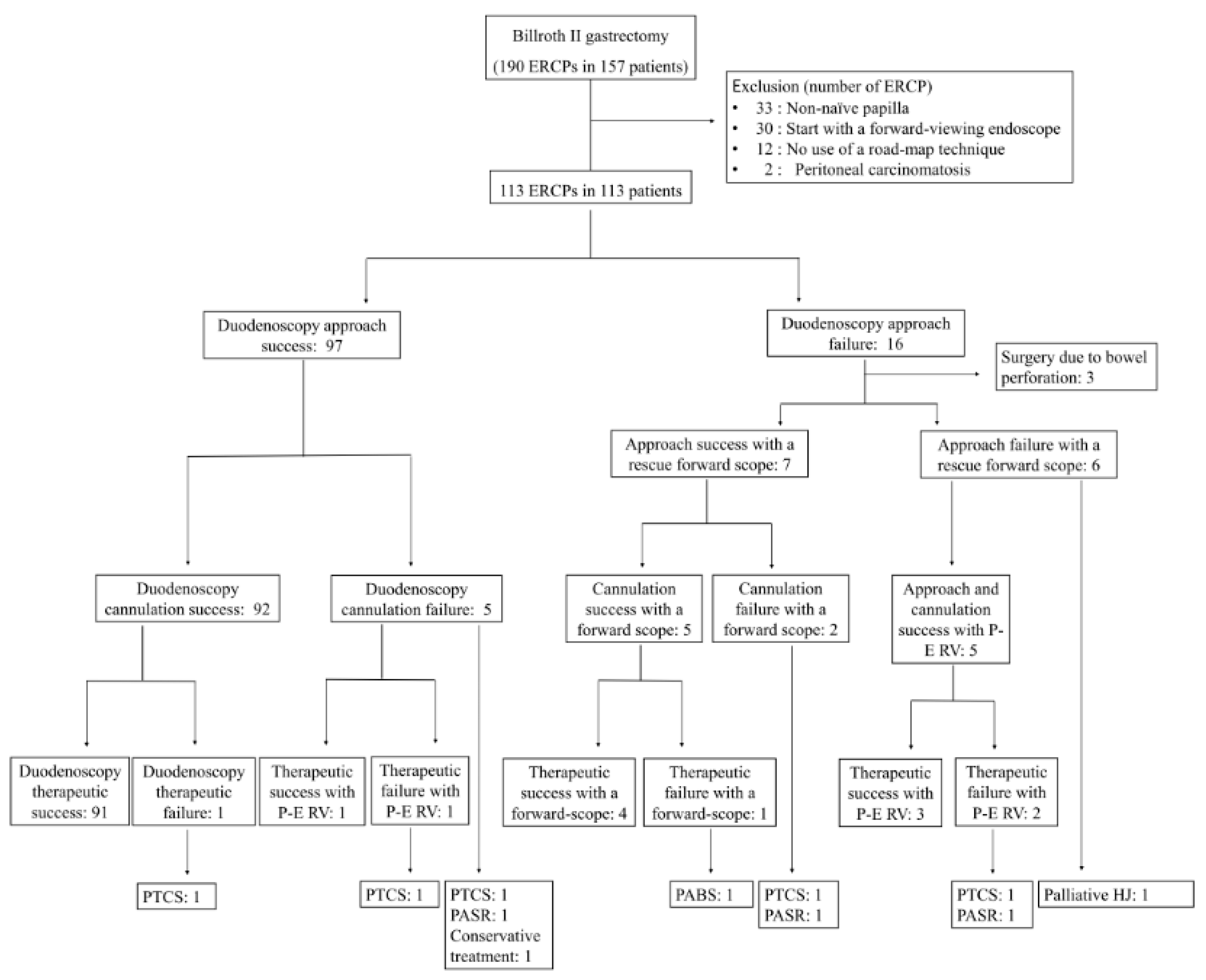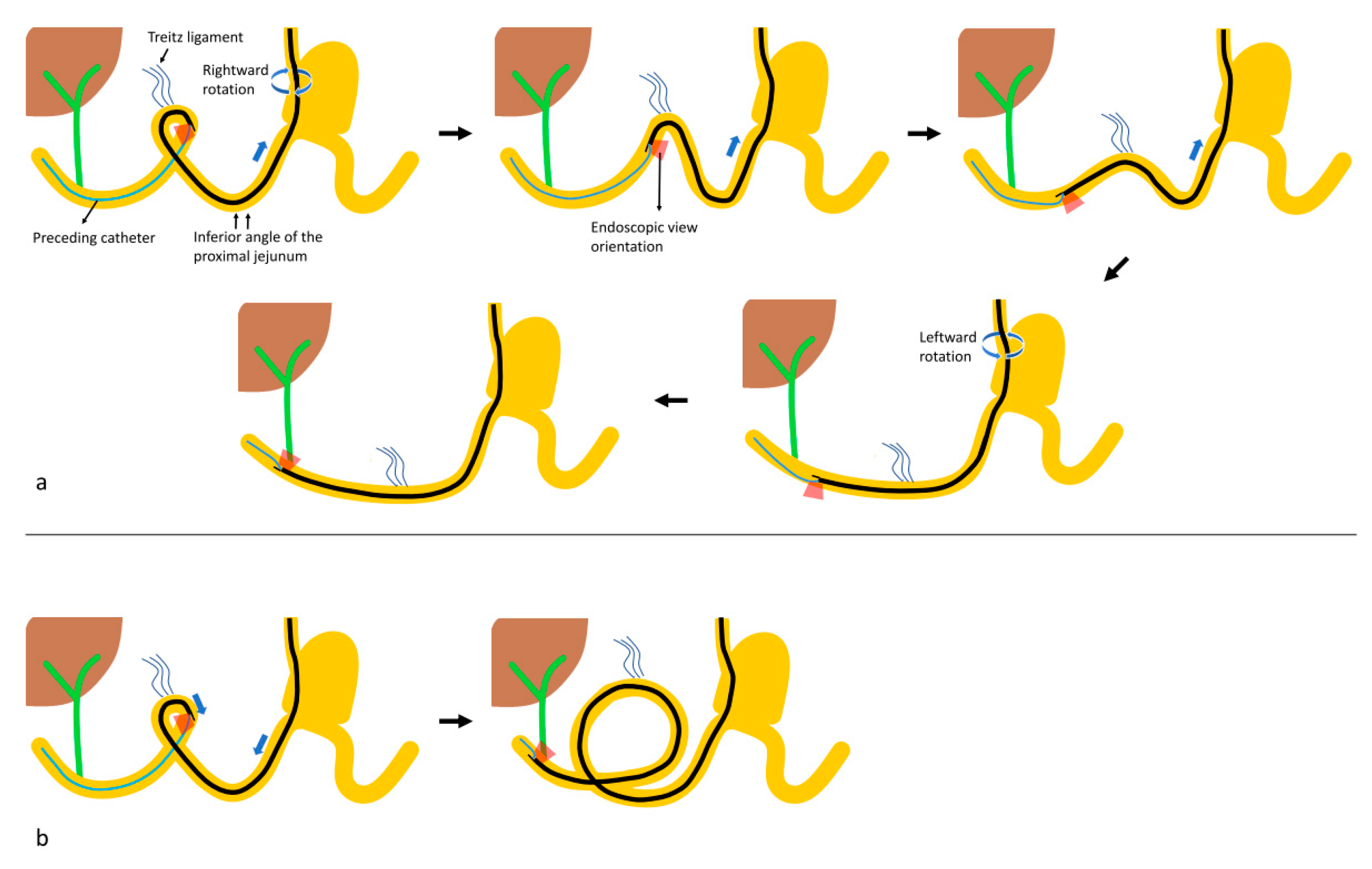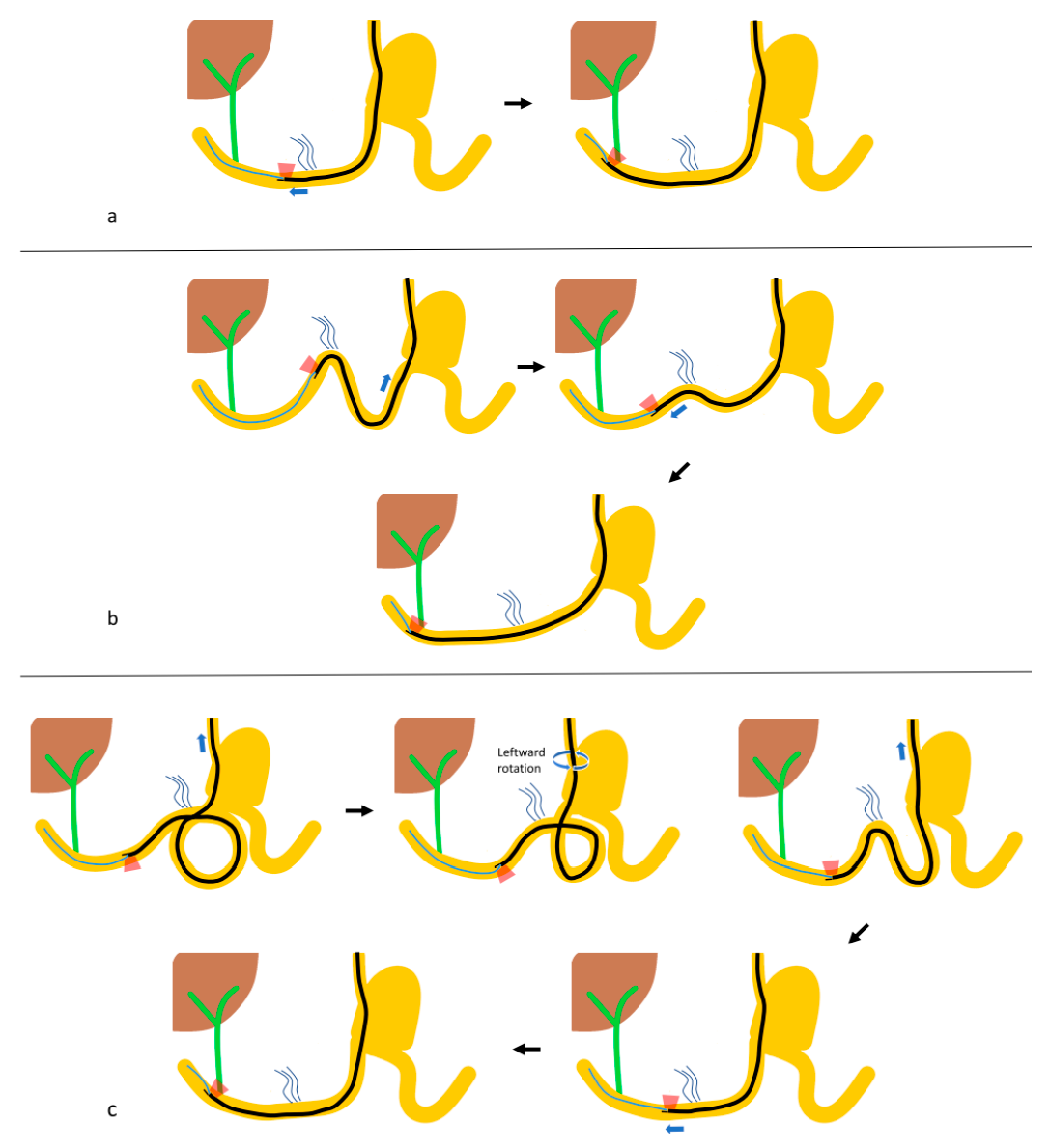Outcomes and Loop Pattern Analysis of a Road-Map Technique for ERCP with Side-Viewing Duodenoscope in Patients with Billroth II Gastrectomy (with Video)
Abstract
1. Introduction
2. Materials and Methods
2.1. Patients
2.2. ERCP Procedures
2.3. Outcome Measurements
2.4. Statistical Analyses
3. Results
4. Discussion
Supplementary Materials
Author Contributions
Funding
Institutional Review Board Statement
Informed Consent Statement
Conflicts of Interest
References
- Adler, D.G.; Baron, T.H.; Davila, R.E.; Egan, J.; Hirota, W.K.; Leighton, J.A.; Qureshi, W.; Rajan, E.; Zuckerman, M.J.; Fanelli, R.; et al. Standards of Practice Committee of American Society for Gastrointestinal E. ASGE guideline: The role of ERCP in diseases of the biliary tract and the pancreas. Gastrointest. Endosc. 2005, 62, 1–8. [Google Scholar] [CrossRef] [PubMed]
- Bove, V.; Tringali, A.; Familiari, P.; Gigante, G.; Boskoski, I.; Perri, V.; Mutignani, M.; Costamagna, G. ERCP in patients with prior Billroth II gastrectomy: Report of 30 years’ experience. Endoscopy 2015, 47, 611–616. [Google Scholar] [CrossRef] [PubMed]
- Krutsri, C.; Kida, M.; Yamauchi, H.; Iwai, T.; Imaizumi, H.; Koizumi, W. Current status of endoscopic retrograde cholangiopancreatography in patients with surgically altered anatomy. World J. Gastroenterol. 2019, 25, 3313–3333. [Google Scholar] [CrossRef] [PubMed]
- Easler, J.J.; Sherman, S. Cap-assisted pancreaticobiliary endoscopy in Billroth II anatomy: ERCP “through the looking glass”. Gastrointest. Endosc. 2016, 83, 1202–1204. [Google Scholar] [CrossRef] [PubMed][Green Version]
- Kim, M.H.; Lee, S.K.; Lee, M.H.; Myung, S.J.; Yoo, B.M.; Seo, D.W.; Min, Y.I. Endoscopic retrograde cholangiopancreatography and needle-knife sphincterotomy in patients with Billroth II gastrectomy: A comparative study of the forward-viewing endoscope and the side-viewing duodenoscope. Endoscopy 1997, 29, 82–85. [Google Scholar] [CrossRef] [PubMed]
- Park, T.Y.; Bang, C.S.; Choi, S.H.; Yang, Y.J.; Shin, S.P.; Suk, K.T.; Baik, G.H.; Kim, D.J.; Yoon, J.H. Forward-viewing endoscope for ERCP in patients with Billroth II gastrectomy: A systematic review and meta-analysis. Surg. Endosc. 2018, 32, 4598–4613. [Google Scholar] [CrossRef] [PubMed]
- Wu, W.G.; Mei, J.W.; Zhao, M.N.; Zhang, W.J.; Gu, J.; Tao, Y.J.; Liu, Y.B.; Wang, X.F. Use of the Conventional Side-viewing Duodenoscope for Successful Endoscopic Retrograde Cholangiopancreatography in Postgastrectomy Patients. J. Clin. Gastroenterol. 2016, 50, 244–251. [Google Scholar] [CrossRef] [PubMed][Green Version]
- Wu, W.G.; Zhang, W.J.; Gu, J.; Zhao, M.N.; Zhuang, M.; Tao, Y.J.; Liu, Y.B.; Wang, X.F. Retrieval-balloon-assisted enterography for ERCP after Billroth II gastroenterostomy and Braun anastomosis. World J. Gastroenterol. 2014, 20, 10921–10926. [Google Scholar] [CrossRef] [PubMed]
- Cotton, P.B.; Eisen, G.M.; Aabakken, L.; Baron, T.H.; Hutter, M.M.; Jacobson, B.C.; Mergener, K.; Nemcek, A., Jr.; Petersen, B.T.; Petrini, J.L.; et al. A lexicon for endoscopic adverse events: Report of an ASGE workshop. Gastrointest. Endosc. 2010, 71, 446–454. [Google Scholar] [CrossRef] [PubMed]
- Yokoe, M.; Hata, J.; Takada, T.; Strasberg, S.M.; Asbun, H.J.; Wakabayashi, G.; Kozaka, K.; Endo, I.; Deziel, D.J.; Miura, F.; et al. Tokyo Guidelines 2018: Diagnostic criteria and severity grading of acute cholecystitis (with videos). J. Hepatobiliary Pancreat. Sci. 2018, 25, 41–54. [Google Scholar] [CrossRef] [PubMed]
- Kiriyama, S.; Kozaka, K.; Takada, T.; Strasberg, S.M.; Pitt, H.A.; Gabata, T.; Hata, J.; Liau, K.H.; Miura, F.; Horiguchi, A.; et al. Tokyo Guidelines 2018: Diagnostic criteria and severity grading of acute cholangitis (with videos). J. Hepatobiliary Pancreat. Sci. 2018, 25, 17–30. [Google Scholar] [CrossRef] [PubMed]
- Park, T.Y.; Song, T.J. Recent advances in endoscopic retrograde cholangiopancreatography in Billroth II gastrectomy patients: A systematic review. World J. Gastroenterol. 2019, 25, 3091–3107. [Google Scholar] [CrossRef] [PubMed]
- Tanisaka, Y.; Ryozawa, S.; Mizuide, M.; Harada, M.; Fujita, A.; Ogawa, T.; Nonaka, K.; Tashima, T.; Araki, R. Analysis of the factors involved in procedural failure: Endoscopic retrograde cholangiopancreatography using a short-type single-balloon enteroscope for patients with surgically altered gastrointestinal anatomy. Dig. Endosc. 2019, 31, 682–689. [Google Scholar] [CrossRef] [PubMed]
- Shimatani, M.; Hatanaka, H.; Kogure, H.; Tsutsumi, K.; Kawashima, H.; Hanada, K.; Matsuda, T.; Fujita, T.; Takaoka, M.; Yano, T.; et al. Diagnostic and Therapeutic Endoscopic Retrograde Cholangiography Using a Short-Type Double-Balloon Endoscope in Patients with Altered Gastrointestinal Anatomy: A Multicenter Prospective Study in Japan. Am. J. Gastroenterol. 2016, 111, 1750–1758. [Google Scholar] [CrossRef] [PubMed]



| Age, mean ± SD | 70.9 ± 9.4 |
| Sex, n (%) | 84 (74.3)/29 (25.7) |
| Reconstruction type, n (%) | |
| Billroth II/Billroth II with Braun anastomosis | 84 (74.3)/29 (25.7) |
| Antecolic/retrocolic | 83 (73.5)/30 (26.5) |
| Billroth II gastrectomy indication, n (%) | |
| Gastric cancer/peptic ulcer | 78 (69.0))/35 (31.0) |
| Duration from Billroth II gastrectomy, n (%) | |
| ≤5 year/>5 years | 25 (22.1)/88 (77.9) |
| Reasons for ERCP, n (%) | |
| Common bile duct stone suspicion | 83 (73.5) |
| Indeterminate biliary stricture | 6 (5.3) |
| Malignant biliary stricture | 21 (18.6) |
| Recurred gastric cancer | 6 |
| Cholangiocarcinoma (hilar/distal) | 8 (2/6) |
| Pancreatic cancer | 4 |
| Ampullary cancer | 2 |
| Gallbladder cancer | 1 |
| Bile leakage | 1 (0.9) |
| Pancreatic duct leakage/chronic pancreatitis | 2 (1.8) |
| Periampullary diverticulum, n (%) | 33 (29.7) |
| Preprocedural laboratory finding, mean ± SD | |
| White blood cell,/µL | 8076 ± 4155 |
| Hemoglobin, g/dL | 11.8 ± 1.6 |
| Total bilirubin, mg/dL | 3.2 ± 4.2 |
| Used catheter, n (%) | |
| Rotatable sphincterotome/triple-lumen balloon catheter | 73 (64.6)/40 (35.4) |
| Duodenoscopy/overall approach success, n (%) | 97 (85.8)/109 (96.5) |
| Causes of duodenoscopy approach failure, n | 16 |
| Bowel perforation occurrence | 2 |
| Long U-loop formation before reaching the ligament of Treitz | 10 |
| Failure in passing the ligament of Treitz | 4 |
| Duodenoscopy/overall cannulation success, n (%) | 92 (81.4)/104 (92.0) |
| Duodenoscopy/overall therapeutic success, n (%) | 91 (80.5)/99 (87.6) |
| Reasons for overall therapeutic failure, n | 14 |
| Approach failure albeit forward scope or P-E RV | 1 |
| Cannulation failure/occurrence of bowel perforation | 6/3 |
| Failure in complete stone extraction | 3 |
| Failure in biliary stenting due to tight stricture | 1 |
| Rescue methods for overall therapeutic failure, n (%) | |
| PTCS/percutaneous antegrade stone removal | 5/3 |
| Percutaneous antegrade stenting/palliative hepaticojejunostomy | 1/1 |
| Conservative treatment | 1 |
| Surgery following bowel perforation | 3 |
| Primary repair and cholecystectomy | 1 |
| Primary repair and cholecystectomy and choledochotomy | 2 |
| Overall adverse events, n (%) | 8 (7.1) |
| Duodenoscope-related perforation | 3(2.7) |
| Pancreatitis | 3 (2.7) |
| Cholecystitis | 1 (0.9) |
| Transient respiratory failure | 1 (0.9) |
| Reverse ɣ-loop * | 29 (29.9%) |
| Fixed reverse ɣ-loop | 5 (5.2%) |
| Simple U-loop | 22 (22.7%) |
| N-loop * | 28 (28.9%) |
| Reverse α-loop * | 13 (13.4%) |
Publisher’s Note: MDPI stays neutral with regard to jurisdictional claims in published maps and institutional affiliations. |
© 2021 by the authors. Licensee MDPI, Basel, Switzerland. This article is an open access article distributed under the terms and conditions of the Creative Commons Attribution (CC BY) license (https://creativecommons.org/licenses/by/4.0/).
Share and Cite
Yang, M.J.; Kim, J.H.; Hwang, J.C.; Yoo, B.M.; Li, Y.J.; Kim, S.S.; Lim, S.G. Outcomes and Loop Pattern Analysis of a Road-Map Technique for ERCP with Side-Viewing Duodenoscope in Patients with Billroth II Gastrectomy (with Video). J. Pers. Med. 2021, 11, 404. https://doi.org/10.3390/jpm11050404
Yang MJ, Kim JH, Hwang JC, Yoo BM, Li YJ, Kim SS, Lim SG. Outcomes and Loop Pattern Analysis of a Road-Map Technique for ERCP with Side-Viewing Duodenoscope in Patients with Billroth II Gastrectomy (with Video). Journal of Personalized Medicine. 2021; 11(5):404. https://doi.org/10.3390/jpm11050404
Chicago/Turabian StyleYang, Min Jae, Jin Hong Kim, Jae Chul Hwang, Byung Moo Yoo, Yu Ji Li, Soon Sun Kim, and Sun Gyo Lim. 2021. "Outcomes and Loop Pattern Analysis of a Road-Map Technique for ERCP with Side-Viewing Duodenoscope in Patients with Billroth II Gastrectomy (with Video)" Journal of Personalized Medicine 11, no. 5: 404. https://doi.org/10.3390/jpm11050404
APA StyleYang, M. J., Kim, J. H., Hwang, J. C., Yoo, B. M., Li, Y. J., Kim, S. S., & Lim, S. G. (2021). Outcomes and Loop Pattern Analysis of a Road-Map Technique for ERCP with Side-Viewing Duodenoscope in Patients with Billroth II Gastrectomy (with Video). Journal of Personalized Medicine, 11(5), 404. https://doi.org/10.3390/jpm11050404






